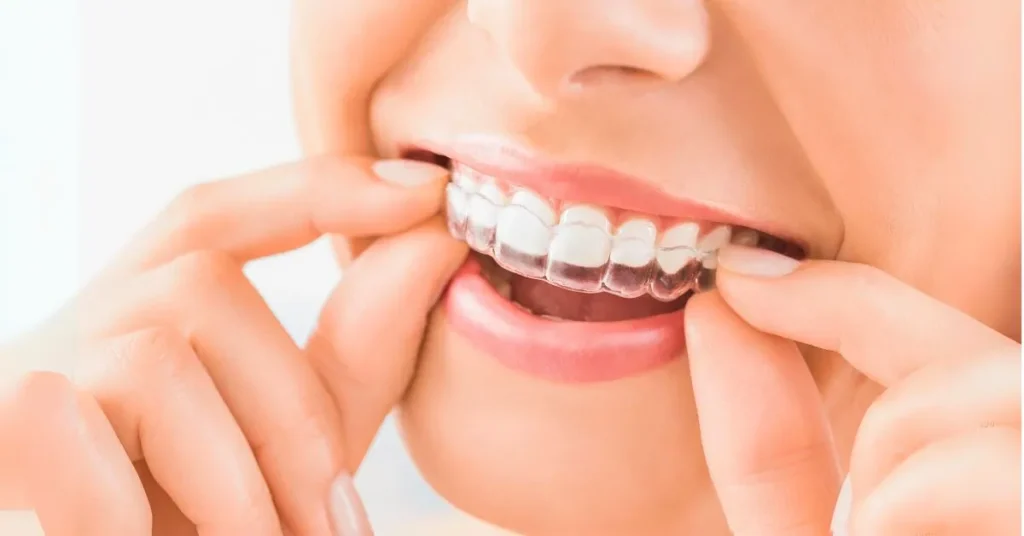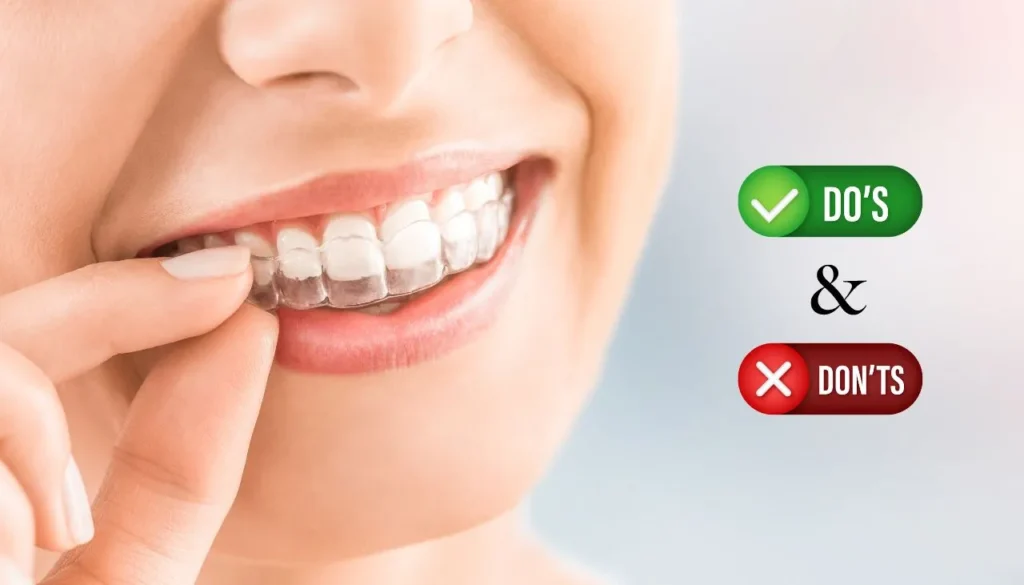If you’ve already experienced orthodontic treatment with braces, you know there’s an extensive list of foods to avoid. So be happy and wave a goodbye to all those days, as with removable aligners, your diet is no longer restricted. So now questions have arrived: Can you eat with clear aligners? Is there anything you should avoid?
Well, this blog will discuss some primary guidelines for clear aligner care and rules for eating and drinking.
Rules for Eating with Clear Aligners
Remove Before Eating:
First things first, you have to remove your clear aligner before eating anything. Your aligners are strong and durable, but they are not meant to undergo the pressure of chewing. The most significant advantage of clear aligners over traditional metal braces is that they are removable, so just remove them before eating. Otherwise, you risk damaging your aligners and disrupting your treatment timeline! So never consider eating with your aligners.
Avoid Certain Foods:
Sticky, chewy, starchy, and satiny food should be avoided, as the constant chewing motion and sticky gum will cause your aligners to rub against your teeth and each other. So people who are thinking it’s fine to eat with aligners, you are not only harming your aligners but your teeth straightening process as well.
Rinse After Eating:
Always rinse your mouth and aligners with water after meals to prevent food particles from getting trapped between your aligner and your teeth.
Brush Teeth Before Reinserting:
Make a habit of brushing your teeth with toothpaste followed by mouthwash to ensure clear teeth before reinserting your clear aligners.
Stay Hydrated:
Having enough water is considered an overall healthy habit in any circumstances. Enough oral hydration is necessary for maintaining good oral health and preventing bacterial growth inside the mouth. During the treatment period with clear aligners, many patients complain of dry mouth issues. Staying hydrated with enough can clear all such hindrances.
Rules for Drinking with Clear Aligners
Drinking Water with Aligners:
Your clear aligners are custom-made to be transparent and discreet. That is why the only thing you can have with aligners is clear water, and that too at room temperature! All other things have their potential threats of damaging the aligner tray.
Avoid Staining Beverages:
Colored beverages such as coffee or wine compromise the integrity of your aligners. This leads to discolouration in your aligner trays and stained teeth. Plus, sugary drinks can cause build-up on your teeth, which increases the risk of cavities and gum disease.
Remove for Hot Drinks:
Sipping hot drinks with aligners is also prohibited as it can bend or wrap the aligners.
Alcohol:
Alcohol consumption is injurious to health. Alcoholic beverages like wine, coloured cocktails, and others may affect the transparency of the aligner trays with colour stains.
How to eat with Clear Aligners?
No aligner system is designed with eating in mind. That means that anything you choose to eat could cause damage to your aligner or impact your teeth straightening treatment negatively.
Starchy foods like potato chips, bread and pasta are particularly problematic, as are sugary foods like cookies, cakes, candy and ice cream. These food items can lead to tooth decay and cavities if they’re trapped between your teeth and aligners for a length of time.
Hard foods like nuts and apples can also warp your aligner due to the bite force required to chew them. The same goes for biting into remnants of hard candy or even cough drops and throat lozenges.
When it comes to beverages, all drinks besides plain water should be avoided. Sugary sodas, juice and sweet coffee and tea drinks are particularly problematic, as are acidic drinks like energy drinks and some sparkling water beverages.
While you can enjoy ice water, it’s important to note that extremely hot and cold beverages can damage your aligner. Dark beverages like coffee and tea – even if you don’t add sugar — can stain your aligner.
Eating with Aligners: Does It Impact Straightening?
Eating with your aligner is never recommended. Even soft foods and sugar-free gum with xylitol, which can help clean your teeth under normal circumstances, can be problematic when wearing an aligner.
Food particles get trapped, leading to potential tooth decay and cavities. Starch-rich and sugary foods are particularly problematic, but any food stuck between your teeth and your aligner can cause decay to develop. You also run the risk of staining your aligner.
Aligners are not designed to endure the bite force your teeth put on them when eating and doing so can warp your aligner, making it much less effective and jeopardizing its ability to do its job.
Damaging your clear aligners is a serious issue that could impact your dental treatment. The worst part is that you might not notice any wrapping or minor damage until you visit your orthodontist after a certain period of time.
If you damage your aligners by eating with them, that could mean you have to wear them longer than the prescribed time due to untimely damage to the device. Often, a number of people increase their treatment time after eating with clear aligners.
Expert Advice for Aligner Care & Maintenance
Brush Your Teeth After Eating:
Make sure that you clean out your mouth carefully after each snack or meal. This is essential in avoiding any oral health issues that may occur with your dental device in place. Try to keep a dental kit with a toothbrush, toothpaste, and floss on hand so you can quickly clean your teeth no matter where you may be during the day.
Avoid Snacking Extensively:
Eating during clear aligner treatment means removing the aligners multiple times throughout the day. The problem? If you’re eating or snacking frequently, you may take out your aligners and not wear them for the recommended hours. As per American Orthodontic Society’s guideline, it is mandatory to wear your clear aligners for 22 hours a day. Try to ensure that you’re wearing them for the recommended amount of time and limit the amount of time you spend eating to avoid potentially impeding your progress!
Stick to a Strict Routine:
A strict routine is crucial when eating or drinking with invisible aligners. This means brushing your teeth each time you eat or drink something that could stain your teeth or leave food particles in them, avoiding the temptation to try to eat or drink something with the aligners in because you don’t want to take them out, and trying to stick to the same eating windows to prevent any issues that could affect your progress.
Quick tips of using aligners while you are eating at a restaurant or at work:
- Wash your hands before touching your aligner. Clean hands will keep you from spreading germs to your aligner.
- Remove your aligner and rinse it with clean water. Use a cleaner recommended by your orthodontist and a soft-bristled toothbrush before thoroughly drying it.
- Store your aligner in its case. This will help protect it.
- Place your aligner out of reach or away from foot traffic. Falls and accidents can damage it.
- Wait 30 minutes before brushing and flossing so you can put your aligner back in. You should also wash your hands before touching your aligner again.
Final Verdict
Aligners require a certain amount of care, leaving many wondering what they can eat or drink. Ideally you should not eat or drink anything else than water with clear aligners. You should know the pros and cons if you have eaten anything. Treatment with clear aligners is beneficial and works wonders only if you are strict with your guidelines and abide by your orthodontic advice.
FAQs
Yes. You may certainly drink clear water with aligners at room temperature.
You can remove your aligners for a maximum of three hours a day. As per dentist recommendations, leaving your aligners for more than 3 hours is risky for your treatment.
No. Chewing, biting or eating with aligners are restricted.
Brush your aligners with a soft-bristled brush and non-whitening toothpaste, and then rinse thoroughly with water.
No aligners are designed or meant for eating food with them, so remove them before enjoying any sort of food.
References
https://aaoinfo.org/whats-trending/orthodontic-treatment-with-clear-aligners

